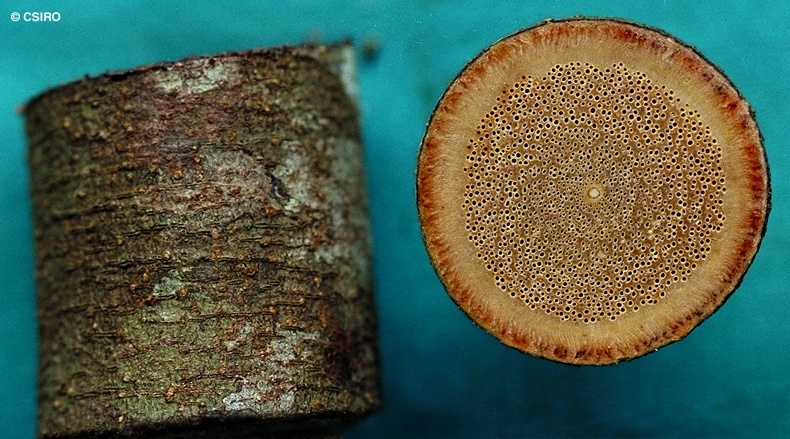Australian Tropical Rainforest Plants - Online edition
Dioclea hexandra (Ralph) Mabb.





Mabberley, D.J. (1980) Taxon 29: 605.
Bejuco de Mato
Vine stem diameters to 4 cm recorded. Exudate watery red, often not immediately obvious. Vessels large, visible to the naked eye in stem cross sections. Narrow dark red stripes often visible in the outer blaze.
Entire plant clothed in erect brown hairs. Leaflet blades about 8.5-14 x 5-9 cm, middle leaflet stalk about 2.5-4 cm long, lateral leaflet stalks about 0.6-0.7 cm long. Middle leaflet blade larger than the lateral leaflet blades. Lateral veins curved throughout their length. Stipules persistent, bifid, attached by the middle, +/- peltate, each lobe about 4-6 mm long, one lobe acute at the apex the other lobe obtuse. Stipels linear, about 2-5 mm long.
Inflorescence about 30-55 cm long, branches short. Calyx tube about 7-8 mm long, calyx lobes about 4-7 mm long. Calyx densely clothed with brown prostrate hairs on both the inner and outer surfaces. Petals: standard about 21 x 25 mm, deep maroon to purple with a yellow central patch; wings about 25 x 10 mm; keel about 17 x 10 mm. Stamens 10 (or stamens + staminodes 10) filaments fused to form a tube about 8-14 mm long. Filament of one stamen free from the tube at the base but joined to the tube further up. Ovary about 25 mm long, densely clothed in brown prostrate hairs. Ovules 4.
Fruits about 7-11 x 4-4.5 cm, slightly constricted between the seeds. Outer surface clothed in brown hairs. Stalk attached to the fruit in a lateral position near the base of the fruit. Seeds two or three per pod, each seed flattened, about 25-30 mm diam. and about 12-13 mm thick. Hilum extending about three quarters of the way around the margin of the seed. Cotyledons about 25 x 23 mm. Radicle about 1.5-2 mm long.
Two or three hairy cataphylls produced before the first pair of leaves. First true leaf simple (unifoliolate) on a long petiole complete with a pulvinus and stipels. Second and subsequent leaves trifoliolate. Leaflets ovate-lanceolate, upper and lower surfaces clothed in pale prostrate hairs. At the tenth leaf stage: leaflets broadly lanceolate, apex acuminate, base obtuse; lateral veins six to nine on each side of the midrib. Both the upper and lower surfaces clothed in prostrate, pale brown hairs. Stalk of the middle leaflet pulvinate and longer than those on the lateral leaflets. Terminal bud and stem clothed in pale brown hairs. Stipules narrowly triangular, about 4-10 mm long, +/- peltate, densely clothed in long spreading hairs. Seedling +/- twining by the tenth leaf stage. Seed germination time 16 to 47 days.
Occurs in NEQ. Altitudinal range quite small, from near sea level to 50 m. Grows in lowland rain forest or swamp forest. May also occur in New Guinea.





